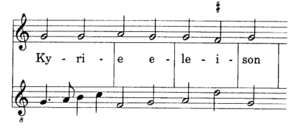Difference between revisions of "Template:ADAM Score Archives"
| Line 13: | Line 13: | ||
* <b>Amadeus</b> at its best produced elegant notation of limitless complexity based in Poeking, DE. (Output was scalable to 1000 dots per inch.) It was a stand-along system that traced its origins to the Atari Mega ST4. Kurt Maas was the designer. | * <b>Amadeus</b> at its best produced elegant notation of limitless complexity based in Poeking, DE. (Output was scalable to 1000 dots per inch.) It was a stand-along system that traced its origins to the Atari Mega ST4. Kurt Maas was the designer. | ||
| + | [[File:Calliope.PNG|300dpi|thumb|right|<small><i>Mensurstriche</i> and <i>musica ficta</i> in an early example from Calliope.</small>]] | ||
* <b>Calliope</b>, graphics-absed program developed in the Cambridge Computing Laboratory by William Clocksin, ran on the NextStep operating system. It offered support for early music, lute tablature, and chant repertories. | * <b>Calliope</b>, graphics-absed program developed in the Cambridge Computing Laboratory by William Clocksin, ran on the NextStep operating system. It offered support for early music, lute tablature, and chant repertories. | ||
| − | |||
* <b>Common Music Notation (CMN)</b>, a LISP-based program by Bill Schottstaedt, was developed at the Center for Computer Research in Music and Acoustics (CCMRA) at Stanford University. Composers using LISP and Heinrich Taube's <i>Common Music</i> were users. | * <b>Common Music Notation (CMN)</b>, a LISP-based program by Bill Schottstaedt, was developed at the Center for Computer Research in Music and Acoustics (CCMRA) at Stanford University. Composers using LISP and Heinrich Taube's <i>Common Music</i> were users. | ||
Revision as of 23:06, 27 October 2022
Werner Icking Music Archive (WIMA)
Website: Werner Icking Music Archive
The recent history of the Werner Icking Music Archive. Icking and several colleagues developed a music-printing capability that was modeled on the TeX metafont and typesetting system. He built an online capability for users to share scores they had edited and typeset themselves. In many cases this included full sets of parts. Some editions were arrangements. MusiTeX (and related dialects) were often traded within the community, but some of the contributions predated the widespread use of the internet. After Icking's death (2001), his archive was administered by a contributor, Christian Mondrup. In 2011-12 it was amalgamated with the IMSLP aggregation. Icking offered an important prototype for current score-interchange sites.
Emerging Desktop Notation Systems of the 1980s and 1990s: A Gallery
The Center for Computer Assisted Research in the Humanities distributed an annual survey to notation-software developers. Examples of specific challenges in notation software were provided. This was a period of rapid change in printing and computer computer technology, as well as operating systems. Nothing stayed the same for long. At its peak the solicitation drew 88 respondents who were eager to show off their latest capabilities. Methods for reproducing their submission, with integrated text and graphics, lagged somewhat behind. Edmund Correia Jr. (a pianist) coordinated the submissions and supervised reproduction of the examples.
In 1994 the IEEE Computer Society published a resume of specific problem types and selected contributions. We made our final solicitation in 1996. By then the dynamism of the field was starting to fade, and a few commercially funded programs began to dominate. We show here a selection of materials as originally submitted. (Some are labeled with details of the printing system used.)
- Amadeus at its best produced elegant notation of limitless complexity based in Poeking, DE. (Output was scalable to 1000 dots per inch.) It was a stand-along system that traced its origins to the Atari Mega ST4. Kurt Maas was the designer.
- Calliope, graphics-absed program developed in the Cambridge Computing Laboratory by William Clocksin, ran on the NextStep operating system. It offered support for early music, lute tablature, and chant repertories.
- Common Music Notation (CMN), a LISP-based program by Bill Schottstaedt, was developed at the Center for Computer Research in Music and Acoustics (CCMRA) at Stanford University. Composers using LISP and Heinrich Taube's Common Music were users.
